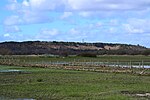RAF Sopley
RAF Sopley was a World War II station, codenamed Starlight, near the village of Sopley in Hampshire. The Radar Station was opened in December 1940. In 1959 it became an air traffic control radar station, and finally closed on 27 September 1974. Nearby Sopley Camp was built in the early 1950s as a domestic site for the radar station and is probably best known as the initial home of the Vietnamese Boat People, in 1979. The camp was sold in 1993 to a local partnership under the name Merryfield Park. Most of the old barracks site had been redeveloped as housing, but the 2-storey building at the Sopley end has been converted into a museum/education centre by Friends Of New Forest Airfields (FONFA). The museum opened in May 2016.
Excerpt from the Wikipedia article RAF Sopley (License: CC BY-SA 3.0, Authors).RAF Sopley
Harpway Lane, New Forest Sopley
Geographical coordinates (GPS) Address Nearby Places Show on map
Geographical coordinates (GPS)
| Latitude | Longitude |
|---|---|
| N 50.779 ° | E -1.771 ° |
Address
Harpway Lane
Harpway Lane
BH23 8ET New Forest, Sopley
England, United Kingdom
Open on Google Maps








